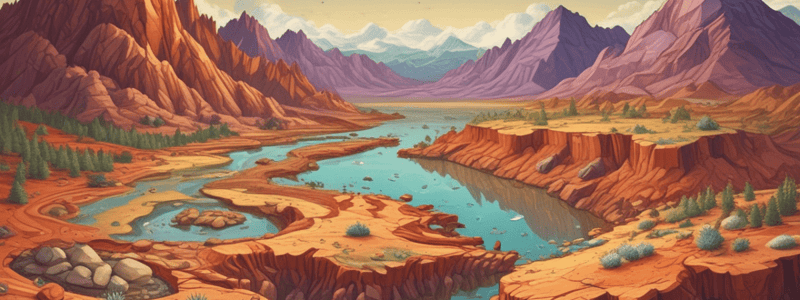Podcast
Questions and Answers
What occurs when crystals in a metamorphic rock recrystallize due to a change in temperature?
What occurs when crystals in a metamorphic rock recrystallize due to a change in temperature?
- New minerals form from the constituents within the rock (correct)
- The rock becomes sedimentary
- The crystals become smaller
- The rock becomes igneous
What is a characteristic of non-foliated metamorphic rocks?
What is a characteristic of non-foliated metamorphic rocks?
- They have visible layers or alignments
- They are always glassy in texture
- They are always foliated
- They can be glassy, sandy, or crystalline in texture (correct)
What type of rock can limestone become through intense heat and pressure?
What type of rock can limestone become through intense heat and pressure?
- Gneiss
- Schist
- Gypsum
- Marble (correct)
What can happen to metamorphic rock through weathering and erosion?
What can happen to metamorphic rock through weathering and erosion?
What can cause extreme accumulations of sediments, leading to metamorphism?
What can cause extreme accumulations of sediments, leading to metamorphism?
What is an example of a foliated metamorphic rock?
What is an example of a foliated metamorphic rock?
What can metamorphic rock become through melting and crystallization?
What can metamorphic rock become through melting and crystallization?
What is a characteristic of the rock cycle?
What is a characteristic of the rock cycle?
What happens to sediments that are buried through natural geological processes?
What happens to sediments that are buried through natural geological processes?
What can happen to igneous rock through weathering and erosion?
What can happen to igneous rock through weathering and erosion?
Flashcards are hidden until you start studying
Study Notes
Rock Life Cycle
- The rock life cycle is the natural Earth process of how rocks form and convert between types.
- There are three types of rocks: igneous, metamorphic, and sedimentary.
- Rocks can take anywhere from hundreds to thousands of years to form or change types.
- The rock cycle can have more than one path, and every rock's life can be unique.
Igneous Rocks
- Formed from molten lava or magma, which is liquid rock.
- Magma crystallizes and forms igneous rocks.
- Can form through volcanic activity, resulting in extrusive igneous rocks.
- Can also form beneath the surface, resulting in intrusive igneous rocks.
- Examples: granite, basalt, diorite.
Sedimentary Rocks
- Formed from sediments that are broken off other rocks and cemented back together.
- Sediments are formed from metamorphic and igneous rocks and even other sedimentary rocks.
- Weathering is the first step in the sedimentary rock cycle, where tiny pieces break off the original rock.
- Erosion moves the broken pieces of rock away and is usually caused by water or wind.
- Deposition occurs when sediments accumulate and compact.
- Lithification occurs when compaction and cementation processes stick sediments together.
- There are three types of sedimentary rocks: clastic, organic, and chemical.
- Clastic sedimentary rocks: formed from clasts, such as conglomerate, shale, and fossiliferous limestones.
- Organic sedimentary rocks: formed from decomposed plants and animals, such as coal.
- Chemical sedimentary rocks: formed from precipitates, such as halite (table salt), limestone, and nodular chert.
Metamorphic Rocks
- Formed from igneous, sedimentary, or other metamorphic rocks.
- Formed through intense pressures and heat processes, and sometimes interaction with fluids.
- Two main processes: contact metamorphism and regional metamorphism.
- Contact metamorphism occurs next to igneous intrusions or hydrothermal fluids.
- Regional metamorphism occurs over a larger area due to tectonic plate collisions.
- Examples: marble, gneiss, schist.
Rock Cycle Examples
- Sediments and rocks can be buried through natural geological processes over time.
- Tectonic processes like convergent plate boundaries cause collisions, which can cause extreme accumulations of sediments.
- Sediments can transform into metamorphic rocks, which can then melt into magma and crystallize to become igneous rocks.
- Igneous rocks can be weathered and eroded away, forming sedimentary rocks again.
Studying That Suits You
Use AI to generate personalized quizzes and flashcards to suit your learning preferences.




